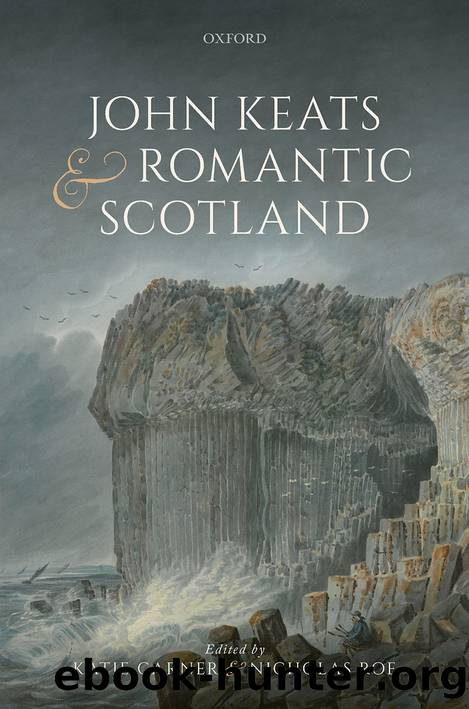John Keats and Romantic Scotland by Katie Garner;Nicholas Roe; & Nicholas Roe

Author:Katie Garner;Nicholas Roe; & Nicholas Roe [Garner, Katie & Roe, Nicholas]
Language: eng
Format: epub
ISBN: 9780191899386
Publisher: OUP Premium
Published: 2022-02-21T00:00:00+00:00
Keats at Burnsâs Grave
Meiko OâHalloran
One of Keatsâs most keenly anticipated pleasures in his walking tour of Scotland with Charles Brown was the prospect of visiting places associated with the great Robert Burns whose poetry he knew and loved.* As he neared Burnsâs Cottage in Alloway, Ayrshire, on 11 July 1818, so confident was Keats of finding inspiration at the poetâs birthplace that he was already anticipating his cherished memory of it in years to come. This would be a momentous and rewarding experience, he felt, and he was excited to share it with his friends, much as he had when he visited Shakespeareâs birthplace with Benjamin Bailey the previous year. Having âmade continual enquiries from the time we saw his Tomb at Dumfriesâ, Keats explained to J. H. Reynolds, he and Brown were reassured of Burnsâs âgreat reputationâ among ordinary people and were now hastening to pay homage at another Burns site (LJK, i. 322). âI begin a letter to you because I am approaching Burnsâs Cottage very fastâ, Keats wrote excitedly:
One of the pleasantest means of annulling self is approaching such a shrine as the Cottage of Burnsâwe need not think of his miseryâthat is all goneâbad luck to itâI shall look upon it hereafter with unmixed pleasure as I do upon my Stratford on <and> Avon day with BaileyâI shall fill this sheet for you in the Bardies Country, going no further than this till I get into the Town of Ayr which will be a 9 milesâ walk to Teaâ.â(LJK, i. 322â3)
Part of Keatsâs eagerness to reach Burnsâs Cottage arose from a desire to dispel his lingering impression of the bardâs âmiseryâ from visiting his tomb ten days earlier. The idea of âannulling selfâ may simply express a longing to be transported beyond himself as he sought poetic inspiration on his journey, but in the context of the letter, it also suggests that Keats had found his visit to Burnsâs tomb personally disturbing and that he wanted to dislodge his dark thoughts about Burns and the implications for himself.
The sonnet Keats composed âOn Visiting the Tomb of Burnsâ on the day of his visit to Dumfries has long been seen as enigmatic and has been interpreted in various ways. For John Middleton Murry, âthe main interest of the sonnet is psychological.â¦We feel that Keats, at this moment, was really suffering. And we should like to understand his sufferingâ.1 Shakespearean echoes in the sonnet have led some critics to draw parallels with Hamlet in the graveyard. Aileen Ward, for example, sees Keats as a Hamlet figure who fancies for a moment that âhe stood not by Burnsâs grave but by his ownâ,2 while George Yost, Jr. offers an interpretation that instead focuses closely on Dante and Spence as sources for Keatsâs Minos.3 However, as Stuart Sperry emphasizes, Keatsâs âpilgrimage to Burnsâs memorialsâ must also be understood as âan attempt to distil from a conflicting set of attitudes a just and fuller sense of that poetâs enduring greatnessâ.4 The
Download
This site does not store any files on its server. We only index and link to content provided by other sites. Please contact the content providers to delete copyright contents if any and email us, we'll remove relevant links or contents immediately.
4 3 2 1: A Novel by Paul Auster(11788)
The handmaid's tale by Margaret Atwood(7447)
Giovanni's Room by James Baldwin(6808)
Asking the Right Questions: A Guide to Critical Thinking by M. Neil Browne & Stuart M. Keeley(5355)
Big Magic: Creative Living Beyond Fear by Elizabeth Gilbert(5351)
Ego Is the Enemy by Ryan Holiday(4956)
On Writing A Memoir of the Craft by Stephen King(4662)
The Body: A Guide for Occupants by Bill Bryson(4581)
Ken Follett - World without end by Ken Follett(4443)
Bluets by Maggie Nelson(4261)
Adulting by Kelly Williams Brown(4232)
Eat That Frog! by Brian Tracy(4149)
Guilty Pleasures by Laurell K Hamilton(4116)
White Noise - A Novel by Don DeLillo(3829)
The Poetry of Pablo Neruda by Pablo Neruda(3814)
Fingerprints of the Gods by Graham Hancock(3738)
Alive: The Story of the Andes Survivors by Piers Paul Read(3730)
The Book of Joy by Dalai Lama(3697)
The Bookshop by Penelope Fitzgerald(3619)
